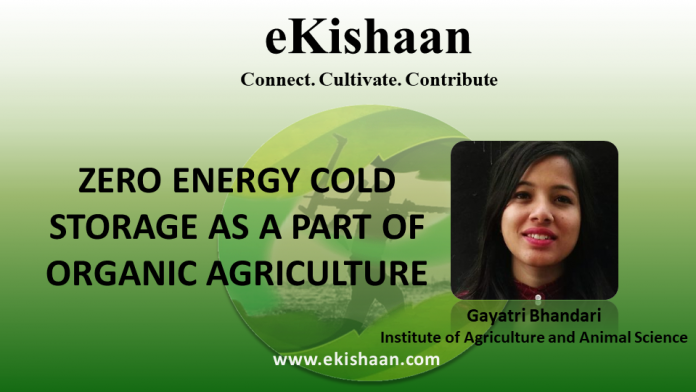ZERO ENERGY COLD STORAGE AS A PART OF ORGANIC AGRICULTURE
Organic agriculture is getting hyped not only for its competitiveness but also because of followers and producers in Nepal. These days most of we Nepali can pay any price to have organic products and interest seem to be rising very fast especially in the urban areas. There is no doubt, Nepal`s has high potential to produce many crops, food spices, fruits, vegetables, essential oil and medicinal plants etc. but are we able to store them? Even if we import thousands of quintals of organic produce to meet the increased demand, are we able to provide them to the market in suffice amount with good storage service? If not then where are we lacking.
Organic crops can be stored using the same methods as conventional crops but there is an increased risk that sometimes there will be higher storage losses because pesticides and sprout suppressants are not used. Based on the limited data available, economic analysis revealed that long term storage of organic vegetables has generally not been profitable. However, as the market expands in the future, it is likely that storage will become as essential for vegetables as it is for organic cereals and fruit.
So there might be the questions, why zero energy cold storage as a part of organic agriculture. The simple is as the statement revealed. It is all about the storage of organic produce which is low-cost alternatives to mitigate maximum problems of Nepalese farmers. Proper storage is definitely an important for marketing and distribution of horticultural commodities which also balances the daily fluctuations of supply and demand. If we talk about Zero energy cool chamber as a storage structure, it is an on-farm rural oriented storage structure which operates on the principle of evaporative cooling and has been constructed using locally available raw materials such as bricks, sand, bamboo, rice straw, vetiver grass, jute cloth etc. The chamber has been constructed above the ground and comprises of a double-walled structure made up of bricks. Zero energy cool chambers (ZECC) is a double wall structure having space between the walls which is filled with porous water absorbing materials. These pads are kept constantly wet by applying water. The construction of ZECC looks simple and its advantage is more simple and yet effective. If we overview at a glance, then can be listed as:
- This could be easily constructed by the farmers themselves using locally available materials and could help in retaining the freshness of vegetables for a short period so that the farmers can store their produce for few days and can send the bulk of their commodity to the wholesale market avoiding distress local sale through middlemen. Better storage can help maintain crop quality for a longer period of time.
- It can be constructed with locally available materials in remote areas and most importantly, it is eco-friendly as it does not need
- It can be used to achieve continuity of supply to their customers and to accumulate produce for peak periods of time. It is even considered to be beneficial to avoid oversupply and saturation of the market at peak harvest time.
- The shelf life of tropical fruits held in the chamber was increased by 2 to 14 days (15–27% increase) as compared to storage at room temperature, and the physiological loss in weight was lower.
- It has greater area of application, which not only helps in storage of processed fruit products but also retain nutritive value and even during plant propagation it can used as a means of help
Only limitation with this system is it requires dry and hot climate (high temperature and less humidity), open space for movement of air and small quantity of water.
Considering, the acute energy shortage in rural areas, there is better scope for adoption of small capacity, low cost, on-farm scientific storage structure which require zero energy. Such a system provides an inexpensive, energy efficient, environmentally benign (not requiring ozone-damaging gas as in active systems) and potentially attractive cooling system. The semi-perishable fruit and vegetables, milk and some products, cooked food, mushroom, meat, fish, flowers and that have a short shelf life can be stored inside the zero energy cool chamber. These all things help in saying; yes we need those systems as a storage structure that can help most of the rural farmers. If it can benefit most of the Nepalese conditions, then we must do which is in our hand. Completely known about the facts that reducing the post-harvest loss is a global need, then why don’t we foster the very easy method by ourselves and take a step to promote it.
